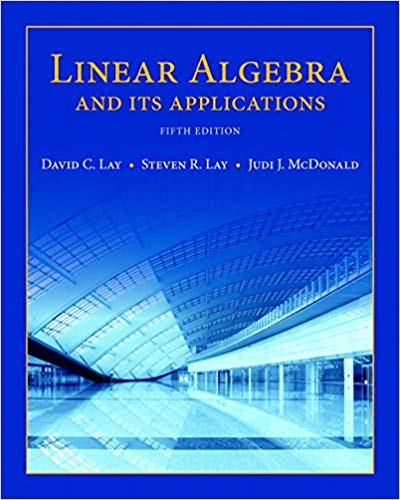
Linear Algebra and Its Applications, 5th Edition
Authors: David C. Lay, Steven R. Lay, Judi J. McDonald
ISBN-13: 978-0321982384
We have solutions for your book!
See our solution for Question 36E from Chapter 2.3 from Lay's Linear Algebra and Its Applications, 5th Edition.
Problem 36E
Chapter:
Problem:
Let T be a linear transformation that maps ℝn onto ℝn. Show that T –1 exists and maps ℝn onto ℝn. Is T –1 also one-to-one?
Step-by-Step Solution
Given Information
We are given that T is a linear transformation that maps $R^n$ onto $R^n$. We have to Show that $T^{-1}$ exists and maps $R^n$ onto $R^n$. we also have to show that is $T^{-1}$ also one-to-one?
Step-1:
A linear transformation $T : \mathbb { R } ^ { n } \rightarrow \mathbb { R } ^ { m }$ with standard matrix A maps $R^n$ onto $R^n$, if and only if columns of A span $R^n$. Hence the columns of matrix A span span $R^n$.
Step-2:
According to the invertible matrix theorem, if A is an $n \times n$ matrix then the statements, A is an invertible and the columns of A span $R^n$ are equivalent. As the columns of matrix span $R^n$, the matrix A is invertible.
Step-3:
The inverse transformation is given by: \[ T ^ { - 1 } ( \mathbf { x } ) = A ^ { - 1 } ( \mathbf { x } ) \] Thus the linear transformation T is invertible. Hence, inverse of T is \[ T ^ { - 1 } ( \mathbf { x } ) = A ^ { - 1 } ( \mathbf { x } ) \]
Step-4:
If a matrix A is invertible, then its inverse is also invertible. Hence, $A^{-1}$ is invertible. So, invertible matrix theorem is true for $A^{-1}$.
According to the invertible matrix theorem, if A is an $n \times n$ invertible matrix then the statements, A is an invertible, the linear transformation $\mathbf { x } \mapsto A \mathbf { x }$ is one-to-one and the linear transformation $\mathbf { x } \mapsto A \mathbf { x }$ maps $R^n$ onto $R^n$ are equivalent. Therefore,
As the matrix $A^{-1}$ is the standard matrix for, $T^{-1}$ the linear transformation $T^{-1}$ is one-to-one and maps $R^n$ onto $R^n$
We are given that T is a linear transformation that maps $R^n$ onto $R^n$. We have to Show that $T^{-1}$ exists and maps $R^n$ onto $R^n$. we also have to show that is $T^{-1}$ also one-to-one?
Step-1:
A linear transformation $T : \mathbb { R } ^ { n } \rightarrow \mathbb { R } ^ { m }$ with standard matrix A maps $R^n$ onto $R^n$, if and only if columns of A span $R^n$. Hence the columns of matrix A span span $R^n$.
Step-2:
According to the invertible matrix theorem, if A is an $n \times n$ matrix then the statements, A is an invertible and the columns of A span $R^n$ are equivalent. As the columns of matrix span $R^n$, the matrix A is invertible.
Step-3:
The inverse transformation is given by: \[ T ^ { - 1 } ( \mathbf { x } ) = A ^ { - 1 } ( \mathbf { x } ) \] Thus the linear transformation T is invertible. Hence, inverse of T is \[ T ^ { - 1 } ( \mathbf { x } ) = A ^ { - 1 } ( \mathbf { x } ) \]
Step-4:
If a matrix A is invertible, then its inverse is also invertible. Hence, $A^{-1}$ is invertible. So, invertible matrix theorem is true for $A^{-1}$.
According to the invertible matrix theorem, if A is an $n \times n$ invertible matrix then the statements, A is an invertible, the linear transformation $\mathbf { x } \mapsto A \mathbf { x }$ is one-to-one and the linear transformation $\mathbf { x } \mapsto A \mathbf { x }$ maps $R^n$ onto $R^n$ are equivalent. Therefore,
As the matrix $A^{-1}$ is the standard matrix for, $T^{-1}$ the linear transformation $T^{-1}$ is one-to-one and maps $R^n$ onto $R^n$